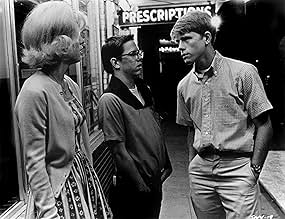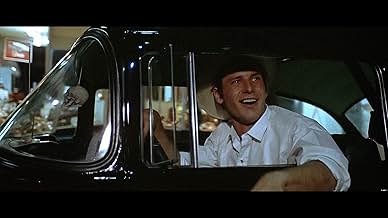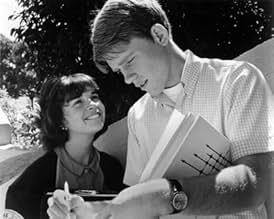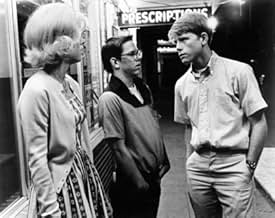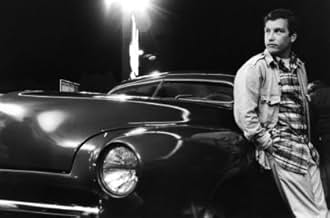A group of teenagers in California's central valley spend one final night after their 1962 high school graduation cruising the strip with their buddies before they pursue their varying goals... Read allA group of teenagers in California's central valley spend one final night after their 1962 high school graduation cruising the strip with their buddies before they pursue their varying goals.A group of teenagers in California's central valley spend one final night after their 1962 high school graduation cruising the strip with their buddies before they pursue their varying goals.
- Nominated for 5 Oscars
- 9 wins & 13 nominations total
Ron Howard
- Steve Bolander
- (as Ronny Howard)
Charles Martin Smith
- Terry Fields
- (as Charlie Martin Smith)
Terence McGovern
- Mr. Wolfe
- (as Terry McGovern)
Kathleen Quinlan
- Peg
- (as Kathy Quinlan)
- Director
- Writers
- All cast & crew
- Production, box office & more at IMDbPro
The Life and Times of Harrison Ford
The Life and Times of Harrison Ford
Take a look back at Harrison Ford's movie career in photos.
Storyline
Did you know
- TriviaDue to the low budget, George Lucas was unable to pay all of the crew members. He offered to give many of them a screen credit in lieu of payment, and they accepted. Traditionally, only department heads received screen credit. Giving screen credit to so many crew members has now become a tradition, which is why closing credits last so long now.
- GoofsThe movie is set in 1962, but a cinema marquee advertises Dementia 13 (1963) (released in 1963). This was done on purpose by George Lucas, because Dementia 13 was Producer Francis Ford Coppola's first movie.
- Quotes
Curt Henderson: You're the most beautiful, exciting thing I've ever seen in my life and I don't know anything about you.
- Crazy creditsWorded epilogues prior to the credits shows what happen to the characters following the movie. While this has since become commonplace in films, it was considered innovative at the time.
- Alternate versionsOriginally released at 110 minutes; re-edited and re-released in a slightly longer version (112 minutes) in 1978 when many of its then-unknown stars became famous.
- ConnectionsFeatured in Airport 1975 (1974)
- SoundtracksAt The Hop
Written by John Madara, Artie Singer and Dave White (uncredited)
Performed by Flash Cadillac (as Flash Cadillac and The Continental Kids)
Produced by Kim Fowley
Courtesy of Roulette Records:
Featured review
I was born at the beginning of the next decade--1970--yet "American Graffiti" was a chord that rippled throughout my life.
My father, who, like George Lucas, grew up in California's Central Valley, said this movie perfectly captured what it was like to grow up there--street cruising, hot rodding, picking up chicks, pulling pranks. Though this movie necessarily sidesteps the boredom inherent in growing up in the pesticide-choked San Joaquin Valley, the place itself is not as important the time it explores. It was a time just before the 1960s descended into the beginning of the end of American culture--the prototypical middle America that existed in almost all its small towns and now has substantively disappeared thanks to the urbanization and suburbanization of much of this country.
The ensemble cast, including so many that went on to become hugely successful in Hollywood--Ron Howard, Cindy Williams (well, with Laverne & Shirley at least), Richard Dreyfuss, and of course Harrison Ford (not to mention Lucas himself)--is handled with great skill from such a young director and reinforces the mystery why Lucas has so horribly mishandled Star Wars Eps. I and II. Lucas simply has been at the Ranch too long and his brilliant career has arrived parked in the garage at a large, entirely perfunctory business and media empire.
Anyway, regardless of Lucas' drift far away from the cutting edge, "American Graffiti" still stands as a kind of monument to his precocity. It is the kind of movie that hits every note with effortless precision, which I think is less the effort of great editing as it is a combination of youthful exuberance and actors and a director at essentially the beginning of their ascent as some of the best in the business.
This movie also withstands the test of time simply because it works magically both for those who have no particular emotional connection to the '60s and for those who were there on nearly equal levels. There is tremendous humor and naturalistic character play and dialog that few can help but be drawn into. Anyone with any sense of history will acknowledge that all the characters are standing at the edge of the deflowering and self-destruction of America in the '60s. It is a time of tremendous innocence, change, and harrowing decisions. The Bay of Pigs, Cuban Missile Crisis, and Vietnam haven't happened yet.
With Iraq and terrorism chewing at our consciousness every day, it's pretty easy for modern youth to identify and yearn for the nostalgia of such innocence.
My father, who, like George Lucas, grew up in California's Central Valley, said this movie perfectly captured what it was like to grow up there--street cruising, hot rodding, picking up chicks, pulling pranks. Though this movie necessarily sidesteps the boredom inherent in growing up in the pesticide-choked San Joaquin Valley, the place itself is not as important the time it explores. It was a time just before the 1960s descended into the beginning of the end of American culture--the prototypical middle America that existed in almost all its small towns and now has substantively disappeared thanks to the urbanization and suburbanization of much of this country.
The ensemble cast, including so many that went on to become hugely successful in Hollywood--Ron Howard, Cindy Williams (well, with Laverne & Shirley at least), Richard Dreyfuss, and of course Harrison Ford (not to mention Lucas himself)--is handled with great skill from such a young director and reinforces the mystery why Lucas has so horribly mishandled Star Wars Eps. I and II. Lucas simply has been at the Ranch too long and his brilliant career has arrived parked in the garage at a large, entirely perfunctory business and media empire.
Anyway, regardless of Lucas' drift far away from the cutting edge, "American Graffiti" still stands as a kind of monument to his precocity. It is the kind of movie that hits every note with effortless precision, which I think is less the effort of great editing as it is a combination of youthful exuberance and actors and a director at essentially the beginning of their ascent as some of the best in the business.
This movie also withstands the test of time simply because it works magically both for those who have no particular emotional connection to the '60s and for those who were there on nearly equal levels. There is tremendous humor and naturalistic character play and dialog that few can help but be drawn into. Anyone with any sense of history will acknowledge that all the characters are standing at the edge of the deflowering and self-destruction of America in the '60s. It is a time of tremendous innocence, change, and harrowing decisions. The Bay of Pigs, Cuban Missile Crisis, and Vietnam haven't happened yet.
With Iraq and terrorism chewing at our consciousness every day, it's pretty easy for modern youth to identify and yearn for the nostalgia of such innocence.
Details
- Release date
- Country of origin
- Language
- Also known as
- American Graffiti: Locura de verano
- Filming locations
- Production companies
- See more company credits at IMDbPro
Box office
- Budget
- $750,000 (estimated)
- Gross US & Canada
- $115,000,000
- Gross worldwide
- $115,006,578
- Runtime1 hour 50 minutes
- Color
- Aspect ratio
- 2.39 : 1
Contribute to this page
Suggest an edit or add missing content






